Prime Minister Janša and his ministerial team today in Ljubljana concluded a government working visit to the central region of Slovenia. This was the last stop in the first round of visits to Slovenian regions, said Mr Janša, and promised to continue with this tradition in the second part of his term.
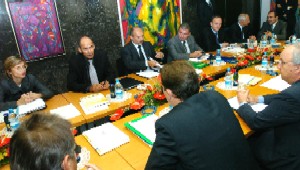
Government’s consultation at the start of the visit to the central Slovenian region (PHOTO: Nebojša Tejić/Salomon 2000)
In the morning the Government held a consultation at the Jožef Stefan Institute about the development prospects of Ljubljana and municipalities in central Slovenia. During their discussion about the transport and environment infrastructure they were confronted with some pessimistic deadlines for the construction or modernisation of access roads to the city. This is linked to a demanding legislation also in terms of environment protection. “We agreed to shorten these deadlines as much as possible because this, after all, implies millions of lost working hours and hours of spare time,” firmly remarked the Prime Minister.
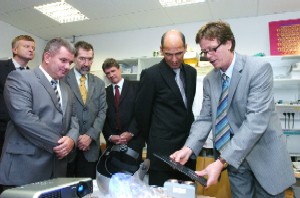
Prime Minister visits the Jožef Stefan Institute (PHOTO: Nebojša Tejić/Salomon 2000)
Prime Minister Janša accompanied by a few ministers held talks with the management of the Jožef Stefan Institute which is with its 800 employees the biggest public research institution in Slovenia. They briefed the Government about the Institute’s endeavours to promote co-operation with the economic sector. In their opinion, co-operation between science and the economy in Slovenia has been slowly improving but knowledge, science and creativity require more promotion and stimulation. Mr Janša pointed out that the decision to start this visit at the Institute was a well-thought one since the Government wished to suitably highlight the Institute’s activities. The Government is well aware of the Institute’s significance and prospects, and expects the economic sector to increase investments in R&D. Small campaigns with great impact – such as the promotion of shortage occupations in secondary schools – are also of great significance.
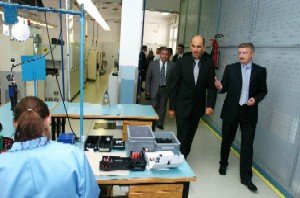
Prime Minister visits Metrel, a measuring and regulation equipment manufacturer (PHOTO: Nebojša Tejić/Salomon 2000)
At the meeting they also exchanged positions on accelerated integration of the Institute into higher education. The Institute should also intensify its participation in European research activities. The hosts informed Mr Janša and his ministers about an increasing demand for staff with a higher education degree in natural sciences. Central Slovenia is by far the richest in development potential, pointed out Mr Janša. “There are many very promising enterprises and, with only the Jožef Stefan Institute in mind, also the biggest concentration of knowledge in the country. We have seen proof of increasing co-operation between the research sector and the economy, we are witnessing developments that have been for many years our wish. We are catching up with the most developed part of the European Union, which is good news,” added the Prime Minister.
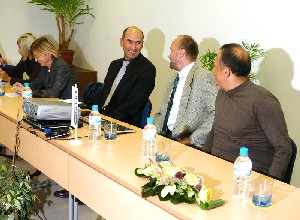
Prime Minister in the Amebis company (PHOTO: Nebojša Tejić/Salomon 2000)
Prime Minister Janša later visited the Metrel company in Horjul which develops, produces and sells measuring instruments and regulation transformers. Metrel exports over 90% of its products. The representatives of the company told Mr Janša that there was a shortage of experts in computer sciences, mechanical and electrical engineering. They also talked about incentives for technological development and innovations as well as opportunities offered by national and European calls for proposals. Views were exchanged on telecommunication infrastructure, its expansion and the ensuing broad band connections for data transfer.
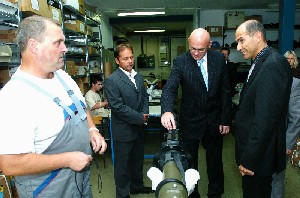
Prime Minister in the production unit of Trival Antene (PHOTO: Nebojša Tejić/Salomon 2000)
Mr Janša also visited Kamnik where the managers of Amebis presented their company and activities. The company develops software in the field of language technologies. Afterwards the Prime Minister visited Trival Antene whose objective is to become one of the world leading companies in development and production of VHF and UHF antennas in the professional market. The company exports 90% of its products to 65 countries, their major customer and supplier is located in the United States. Based on its own development potential, Trival Antene places between 3 and 5 new products on the market every year. Mr Janša and his guests also discussed the company’s plans and vision. He was briefed about problems encountered by this company and other SMEs. They also touched upon the anticipated new investment tenders and promotion of new product development.
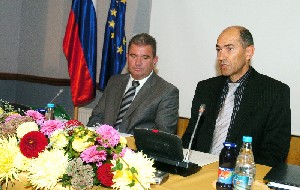
Prime Minister talking about his visit to the region and answering questions at a press conference (PHOTO: Nebojša Tejić/Salomon 2000)
At a press conference in the afternoon, the Prime Minister stressed that the central Slovenian region was by far the most developed as well as the most densely populated, having almost 200 inhabitants per km2. According to the Prime Minister, the best educational structure and the best growth index of the gross domestic product are present here and the region has the best ability to draw money from European funds. It also has the highest number of projects to be financed by the European Union between 2004 and 2006.
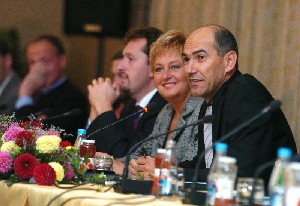
Prime Minister meeting the mayors of the region (PHOTO: Nebojša Tejić/Salomon 2000)
The Prime Minister did, however, point out the numerous differences existing within the region, as the regional statistics do not say everything. There is the Ribnica-Kočevje subregion where indicators of development are a different matter altogether. The development of this region is at the level of 85 per cent of the average Slovenian development, wages and salaries are at around 80 per cent of the Slovenian average, and the population density is only 38 inhabitants per km2. In the Prime Minister's opinion, this shows the existence of big differences within the central Slovenian region and within Slovenia itself. “The data on the region that is developed above the European average do not speak of the quality of life in the entire region,” said the Prime Minister and went on to add that there existed an enormous difference in the possibilities to solve these problems.
“The greatest problem in this region is its infrastructure. There is the problem caused by stationary traffic in Ljubljana and its radial highways. There are many inhabitants regularly commuting to Ljubljana since Ljubljana provides most jobs. Some have easier access than others. Radial highways from the Gorenjska and partly Litija directions are a problem. The biggest problem, however, is the road link towards Ribnica and Kočevje. They need to be resolved on a priority basis," said the Prime Minister. Railways and their out-of-date infrastructure are a problem for the whole country. In Ljubljana, this problem will be addressed shortly by the construction of a new railway station. The remaining modernisation will depend on how soon we shall be able to make available the funds needed for the construction of the entire railway infrastructure.
In the Prime Minister’s words, there are also problems in central Slovenia, existing somewhere between the state and the municipality levels. "The region is what we would need here. It is high time Slovenia was divided into regions. The possibility for this step has been provided by an amendment to the Constitution adopted recently. A package of laws enabling the formation of regions will be introduced in the government procedure in a few weeks. Thus the formal framework will be established to address the difficulties arising somewhere between the state- and local levels, that cannot be tackled by individual municipalities, while it is difficult for the state to deal with so many matters," said the Prime Minister.
In the Resolution on National Development Projects 2007 – 2023 currently under preparation and about to be co-ordinated at the working level in order to be introduced into the government procedure, a major project has been foreseen for central Slovenia, its working title being the business and sports centre. Ljubljana and the region indeed need a central point for fairs and sports – a stadium of sufficient capacity to accommodate major sports events. In the Prime Minister’s opinion, both problems can be addressed simultaneously by one part of the infrastructure being used for both purposes. Private capital can be mobilised to a large extent for this project.
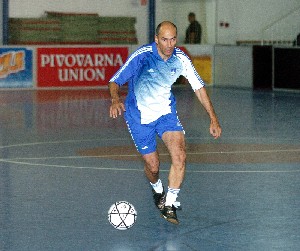
Prime Minister participates in a charity football match (PHOTO: Nebojša Tejić/Salomon 2000)
The Prime Minister and his ministers had a meeting with mayors, economists, deputies and councillors of the National Council from central Slovenia, late in the afternoon in Ljubljana. They discussed development prospects of the region and other topical issues; the ministerial team then answered questions.
In the evening, the ministerial team also played a 7-a-side football match against a team of economists lead by Dr France Arhar. Voluntary contributions raised on this occasion will be used for humanitarian purposes.